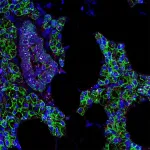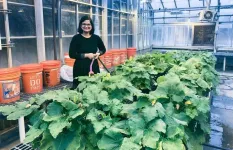INFORMATION:
This research was supported, in part, by the Abdul Latif Jameel Water and Food Systems Lab (J-WAFS) at MIT and the MIT Tata Center for Technology and Design.
Written by Jennifer Chu, MIT News Office
Additional background
Need a water filter? Peel a branch
https://news.mit.edu/2014/need-a-water-filter-peel-a-tree-branch-0226
MIT engineers make filters from tree branches to purify drinking water
Prototypes tested in India show promise as a low-cost, natural filtration option
2021-03-25
(Press-News.org) The interiors of nonflowering trees such as pine and ginkgo contain sapwood lined with straw-like conduits known as xylem, which draw water up through a tree's trunk and branches. Xylem conduits are interconnected via thin membranes that act as natural sieves, filtering out bubbles from water and sap.
MIT engineers have been investigating sapwood's natural filtering ability, and have previously fabricated simple filters from peeled cross-sections of sapwood branches, demonstrating that the low-tech design effectively filters bacteria.
Now, the same team has advanced the technology and shown that it works in real-world situations. They have fabricated new xylem filters that can filter out pathogens such as E. coli and rotavirus in lab tests, and have shown that the filter can remove bacteria from contaminated spring, tap, and groundwater. They also developed simple techniques to extend the filters' shelf-life, enabling the woody disks to purify water after being stored in a dry form for at least two years.
The researchers took their techniques to India, where they made xylem filters from native trees and tested the filters with local users. Based on their feedback, the team developed a prototype of a simple filtration system, fitted with replaceable xylem filters that purified water at a rate of one liter per hour.
Their results, published today in Nature Communications, show that xylem filters have potential for use in community settings to remove bacteria and viruses from contaminated drinking water.
The researchers are exploring options to make xylem filters available at large scale, particularly in areas where contaminated drinking water is a major cause of disease and death. The team has launched an open-source website, with guidelines for designing and fabricating xylem filters from various tree types. The website is intended to support entrepreneurs, organizations, and leaders to introduce the technology to broader communities, and inspire students to perform their own science experiments with xylem filters.
"Because the raw materials are widely available and the fabrication processes are simple, one could imagine involving communities in procuring, fabricating, and distributing xylem filters," says Rohit Karnik, professor of mechanical engineering and associate department head for education at MIT. "For places where the only option has been to drink unfiltered water, we expect xylem filters would improve health, and make water drinkable."
Karnik's study co-authors are lead author Krithika Ramchander and Luda Wang of MIT's Department of Mechanical Engineering, and Megha Hegde, Anish Antony, Kendra Leith, and Amy Smith of MIT D-Lab.
Clearing the way
In their prior studies of xylem, Karnik and his colleagues found that the woody material's natural filtering ability also came with some natural limitations. As the wood dried, the branches' sieve-like membranes began to stick to the walls, reducing the filter's permeance, or ability to allow water to flow through. The filters also appeared to "self-block" over time, building up woody matter that clogged the conduits.
Surprisingly, two simple treatments overcame both limitations. By soaking small cross-sections of sapwood in hot water for an hour, then dipping them in ethanol and letting them dry, Ramchander found that the material retained its permeance, efficiently filtering water without clogging up. Its filtering could also be improved by tailoring a filter's thickness according to its tree type.
The researchers sliced and treated small cross-sections of white pine from branches around the MIT campus and showed that the resulting filters maintained a permeance comparable to commercial filters, even after being stored for up to two years, significantly extending the filters' shelf life.
The researchers also tested the filters' ability to remove contaminants such as E. coli and rotavirus -- the most common cause of diarrheal disease. The treated filters removed more than 99 percent of both contaminants, a water treatment level that meets the "two-star comprehensive protection" category set by the World Health Organization.
"We think these filters can reasonably address bacterial contaminants," Ramchander says. "But there are chemical contaminants like arsenic and fluoride where we don't know the effect yet," she notes.
Groundwork
Encouraged by their results in the lab, the researchers moved to field-test their designs in India, a country that has experienced the highest mortality rate due to water-borne disease in the world, and where safe and reliable drinking water is inaccessible to more than 160 million people.
Over two years, the engineers, including researchers in the MIT D-Lab, worked in mountain and urban regions, facilitated by local NGOs Himmotthan Society, Shramyog, Peoples Science Institute, and Essmart. They fabricated filters from native pine trees and tested them, along with filters made from ginkgo trees in the U.S., with local drinking water sources. These tests confirmed that the filters effectively removed bacteria found in the local water. The researchers also held interviews, focus groups, and design workshops to understand local communities' current water practices, and challenges and preferences for water treatment solutions. They also gathered feedback on the design.
"One of the things that scored very high with people was the fact that this filter is a natural material that everyone recognizes," Hegde says. "We also found that people in low-income households prefer to pay a smaller amount on a daily basis, versus a larger amount less frequently. That was a barrier to using existing filters, because replacement costs were too much."
With information from more than 1,000 potential users across India, they designed a prototype of a simple filtration system, fitted with a receptacle at the top that users can fill with water. The water flows down a 1-meter-long tube, through a xylem filter, and out through a valve-controlled spout. The xylem filter can be swapped out either daily or weekly, depending on a household's needs.
The team is exploring ways to produce xylem filters at larger scales, with locally available resources and in a way that would encourage people to practice water purification as part of their daily lives -- for instance, by providing replacement filters in affordable, pay-as-you-go packets.
"Xylem filters are made from inexpensive and abundantly available materials, which could be made available at local shops, where people can buy what they need, without requiring an upfront investment as is typical for other water filter cartridges," Karnik says. "For now, we've shown that xylem filters provide performance that's realistic."
ELSE PRESS RELEASES FROM THIS DATE:
Scientists find evidence that novel coronavirus infects the mouth's cells
2021-03-25
An international team of scientists has found evidence that SARS-CoV-2, the virus that causes COVID-19, infects cells in the mouth. While it's well known that the upper airways and lungs are primary sites of SARS-CoV-2 infection, there are clues the virus can infect cells in other parts of the body, such as the digestive system, blood vessels, kidneys and, as this new study shows, the mouth. The potential of the virus to infect multiple areas of the body might help explain the wide-ranging symptoms experienced by COVID-19 patients, including oral symptoms such as taste loss, ...
Frequent consumption of meals prepared away from home associated with an increased risk of death
2021-03-25
Philadelphia, March 25, 2021 - Dining out is a popular activity worldwide, but there has been little research into its association with health outcomes. Investigators looked at the association between eating out and risk of death and concluded that eating out very frequently is significantly associated with an increased risk of all-cause death, which warrants further investigation. Their results appear in the Journal of the Academy of Nutrition and Dietetics, published by Elsevier.
Eating out is a popular activity. The US Department of Agriculture recently estimated that Americans' daily energy intake from food away from home increased from 17 percent in 1977-1978 to 34 percent in 2011-2012. At the same time, the number of restaurants has ...
Preservative used in hundreds of popular foods may harm the immune system
2021-03-25
WASHINGTON - A food preservative used to prolong the shelf life of Pop-Tarts, Rice Krispies Treats, Cheez-Its and almost 1,250 other popular processed foods may harm the immune system, according to a new peer-reviewed study by Environmental Working Group.
For the study, published this week in the International Journal of Environmental Research and Public Health, EWG researchers used data from the Environmental Protection Agency's Toxicity Forecaster, or ToxCast, to assess the health hazards of the most common chemicals added to food, as well as the "forever chemicals" known as PFAS, which can migrate to food from packaging.
EWG's analysis of ToxCast data showed that the preservative tert-butylhydroquinone, ...
Failed your New Year resolution again? Join the club
2021-03-25
New Edith Cowan University (ECU) research has found that despite having the best intentions, most people give up on their New Year resolutions within the first month.
The study also revealed that approximately half the people surveyed had the same, or nearly the same, resolution as in the previous year, and more than half of the resolutions listed focused on either diet or exercise.
The research, led by ECU Associate Professor Joanne Dickson, investigated personal goal factors that predicted greater wellbeing and sticking with one's most important New Year resolution over time. Around 180 Australian and UK participants took part in an online survey over a two-month period. ...
Inhibiting impact of dust aerosols on eastern Pacific tropical cyclones from the perspective of energy transmission
2021-03-25
The thermodynamic state of the tropical atmosphere plays an important role in the development of tropical cyclone (TC) intensity. A TC imports thermodynamic energy from ocean-air heat and moisture fluxes and exports heat aloft at the much colder upper troposphere, through a radially and vertically directed overturning circulation in a TC. The work done through this cycle drives the TC's winds.
A negative response of cloud water in the lower troposphere to dust aerosol optical depth (AOD) has recently been reported in Atmospheric and Oceanic Science Letters (https://doi.org/10.1016/j.aosl.2020.100028) by Dr. Zhenxi Zhang from the Inner Mongolia University of Technology, Hohhot, China, by analyzing MERRA-2 reanalysis data and GCM simulations from CMIP6.
"The ...
Anabolic androgenic steroids accelerate brain aging
2021-03-25
Philadelphia, March 25, 2021 - Anabolic androgenic steroids (AAS), a synthetic version of the male sex hormone testosterone, are sometimes used as a medical treatment for hormone imbalance. But the vast majority of AAS is used to enhance athletic performance or build muscle because when paired with strength training. AAS use increases muscle mass and strength, and its use is known to have many side effects, ranging from acne to heart problems to increased aggression. A new study now suggests that AAS can also have deleterious effects on the brain, causing it to age prematurely.
The report appears in Biological Psychiatry: Cognitive Neuroscience and ...
Technology uses 'single' approach to develop electronics, acoustics
2021-03-25
WEST LAFAYETTE, Ind. - A Purdue University innovator has developed a new approach to creating popular thin films used for devices across a broad range of fields, including optics, acoustics and electronics.
Epitaxial lithium niobate (LNO) thin films are an attractive material for electronics and other devices. These films offer flexibility and other properties that are important to manufacturers.
The challenge is that these devices demand high-quality thin films that can be difficult to grow and produce. Haiyan Wang, a Purdue materials engineer, developed a new approach to creating these films. The work is published in Advanced Photonics Research.
"We created an approach ...
NCCN 2021 Virtual Annual Conference addresses cancer care in a year of crisis and innovation
2021-03-25
PLYMOUTH MEETING, PA [March 25, 2021] -- New recommendations to advance racial equity, ways to mitigate the impacts of the COVID-19 pandemic on cancer care, and ongoing strategies for preventing and controlling HPV-associated cancers led the conversation at the National Comprehensive Cancer Network® (NCCN®) 2021 Virtual Annual Conference March 18-20. More than 1,300 attendees from across the United States and more than 40 countries met online to learn about updates to the NCCN Clinical Practice Guidelines in Oncology (NCCN Guidelines®) and new research in the field. Sessions explored supportive care and ways to help survivors return to work, updates on best ...
Revealing complex behavior of a turbulent plume at the calving front of a Greenlandic glacier
2021-03-25
For the first time, scientists have succeeded in continuous monitoring of a subglacial discharge plume, providing a deeper understanding of the glacier-fjord environment.
As marine-terminating glaciers melt, the fresh water from the glacier interacts with the seawater to form subglacial discharge plumes, or convective water flows. These turbulent plumes are known to accelerate the melting and breakup (calving) of glaciers, drive fjord-scale circulation and mixing, and create foraging hotspots for birds. Currently, the scientific understanding of the dynamics of subglacial plumes based on direct measurements is limited to isolated instances.
A team of scientists consisting of Hokkaido University's Assistant Professor Evgeny A. Podolskiy and Professor Shin Sugiyama, and the ...
Genome sequenced for pesky pumpkin pathogen
2021-03-24
URBANA, Ill. - Pumpkin growers dread the tiny tan scabs that form on their fruit, each lesion a telltale sign of bacterial spot disease. The specks don't just mar the fruit's flesh, they provide entry points for rot-inducing fungus and other pathogens that can destroy pumpkins and other cucurbits from the inside out. Either way, farmers pay the price, with marketable yields reduced by as much as 90%.
Despite the disease's severity, scientists don't know much about the genetics of the pathogen that causes it; nearly all the molecular information required for accurate diagnostic testing and targeted treatments is lacking for the disease.
In a new study, University of Illinois scientists, with the help of two undergraduate students, have assembled the first complete ...
LAST 30 PRESS RELEASES:
Numbers in our sights affect how we perceive space
SIMJ announces global collaborative book project in commemoration of its 75th anniversary
Air pollution exposure and birth weight
Obstructive sleep apnea risk and mental health conditions among older adults
How talking slows eye movements behind the wheel
The Ceramic Society of Japan’s Oxoate Ceramics Research Association launches new international book project
Heart-brain connection: international study reveals the role of the vagus nerve in keeping the heart young
Researchers identify Rb1 as a predictive biomarker for a new therapeutic strategy in some breast cancers
Survey reveals ethical gaps slowing AI adoption in pediatric surgery
Stimulant ADHD medications work differently than thought
AI overestimates how smart people are, according to HSE economists
HSE researchers create genome-wide map of quadruplexes
Scientists boost cell "powerhouses" to burn more calories
Automatic label checking: The missing step in making reliable medical AI
Low daily alcohol intake linked to 50% heightened mouth cancer risk in India
American Meteorological Society announces Rick Spinrad as 2026 President-Elect
Biomass-based carbon capture spotlighted in newly released global climate webinar recording
Illuminating invisible nano pollutants: advanced bioimaging tracks the full journey of emerging nanoscale contaminants in living systems
How does age affect recovery from spinal cord injury?
Novel AI tool offers prognosis for patients with head and neck cancer
Fathers’ microplastic exposure tied to their children’s metabolic problems
Research validates laboratory model for studying high-grade serous ovarian cancer
SIR 2026 delivers transformative breakthroughs in minimally invasive medicine to improve patient care
Stem Cell Reports most downloaded papers of 2025 highlight the breadth and impact of stem cell research
Oxford-led study estimates NHS spends around 3% of its primary and secondary care budget on the health impacts of heat and cold in England
A researcher’s long quest leads to a smart composite breakthrough
Urban wild bees act as “microbial sensors” of city health.
New study finds where you live affects recovery after a hip fracture
Forecasting the impact of fully automated vehicle adoption on US road traffic injuries
Alcohol-related hospitalizations from 2016 to 2022
[Press-News.org] MIT engineers make filters from tree branches to purify drinking waterPrototypes tested in India show promise as a low-cost, natural filtration option




